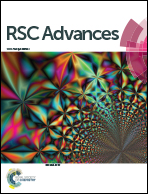Degradation characterization and pathway analysis of chlortetracycline and oxytetracycline in a microbial fuel cell
Abstract
The wide presence of antibiotics in the environment has raised concerns about their potential impact on ecological and human health. This study was conducted to evaluate the degradation of antibiotics (chlortetracycline (CTC) and oxytetracycline (OTC)) in microbial fuel cells (MFCs) and the change of toxicity. The degradation rates of 60 mg L−1 CTC and OTC in the MFCs were 74.2% and 78%, respectively, within 7 days. The degradation ability of the two antibiotics followed the order of OTC > CTC. Toxicity test results of the zebrafish illustrated the toxicity of OTC and CTC was largely eliminated by MFC treatment. Furthermore, possible degradation pathways of CTC and OTC were speculated using LC-MS analysis. High-throughput sequencing analysis indicated that Petrimonas, Azospirillum, Dokdonella, Burkholderia and Stenotrophomonas were the predominant genera in the MFC anode biofilm. Therefore, this work is of great significance for future studies on the treatment of antibiotics in wastewater by MFCs.



 Please wait while we load your content...
Please wait while we load your content...